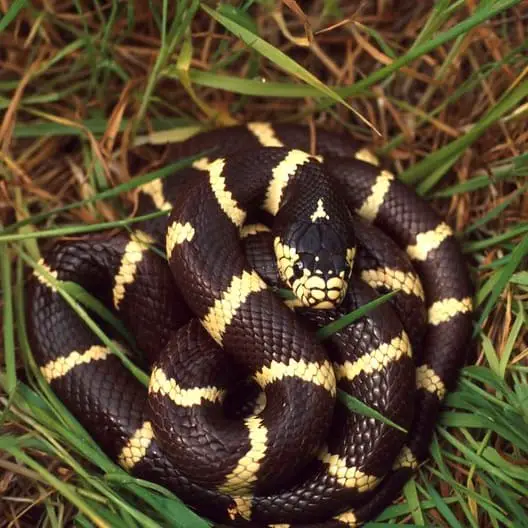The California kingsnake is a nonvenomous snake found in the Western United States, in Northwestern Mexico and as an invasive species in Gran Canaria. It is black or brown with sefveral yellow or cream-colored rings. Until 2009, the California kingsnake was considered a subspecies of the common kingsnake (Lampropeltis getula) and is still somtimes referred to as Lampropeltis getula californiae.
Description
The California kingsnake is black or dark brown and has between 21 and 44 white, cream-colored or light yellow rings.

Some individuals, especially those found on the Pacific coast, have a thin white or yellow longitudinal line running down the back from the neck to the tail. The line can be either in combination with the yellow crossbands or be the only coloration.

The head of the snake is thin and its pupils are round. In the west of its range, the California kingsnake overlaps and often interbreeds with the desert kingsnake. Therefore, a definitive identification between the two species in these areas can be difficult.
The California kingsnake has long been a favorite pet snake and is popular with breeders. Therefore, in captivity, a wide range of color variations and morphs exist. Their appearance can vary greatly from the specimen found in the wild.
Size
California kingsnakes are slightly smaller than their close relative, the eastern kingnsnake. Adults reach an average size of 30-45 inches (80-115 cm). Very large California kingsnakes can reach a length of up to 60 inches (150 cm).

Hunting Behavior and Habitat
The California kingsnake is most often found in wet habitats like swamps and close to rivers. It is a constrictor snake and preys on snakes, turtle eggs, lizards, amphibians and other reptiles.
It also feeds on venomous snakes such as rattlesnakes. To limit the risk of being bitten, the king snake attacks its prey by biting and fixating its head, thus preventing it from opening its jaws. It then gradually swallows its victim while still alive. During this process, it always keeps the prey’s head constrained. California kingsnakes are constrictor snakes and according to studies, they have the strongest constriction power relative to their size of any snake species in the world.
Like other kingsnake species, the California kingsnake is resistant to the venom of rattlesnakes and copperhead and cottonmouth snakes. So even if they get bitten while trying to eat them, they will most likely be fine. However, a large amount of venom or a large number of intense bites can still harm and possibly kill a king snake. Their preference to eat other snakes has earned it the name kingsnake, the king of the snakes.
Bite
Kingsnakes are nonvenomous snakes and harmless for humans. Due to their docile behavior and beautiful black and yellow color patterns, California kingsnakes are a popular pet snake and have been bred into various color morphs. If handled or if the feel threatened, king snakes can sometimes bite or release a foul-smelling musk from their cloaca. Their bite is not medically significant for humans but should be disinfected as any open wound.

Calfornia kingsnake range in the USA
The California kingsnake can be found in the Western United States and Northern Mexico. In the U.S., it can be found in the following states: California, Arizona, Nevada, Utah, Eastern Colorado and Oregon.
Scientific classification of Lampropeltis californiae
- Kingdom: Animalia
- Phylum: Chordata
- Class: Reptilia
- Order: Squamata
- Suborder: Serpentes
- Family: Colubridae
- Genus: Lampropeltis
- Species: Lampropeltis californiae
The California kingsnake has been elevated to species level in 2009. Previously, it was considered a subspecies of the common kingsnake and is still sometimes refereed to as Lampropeltis getula california. The previous subspecies of the common kingsnake, Lampropeltis getula nigrita, was merged with the California kingsnake.